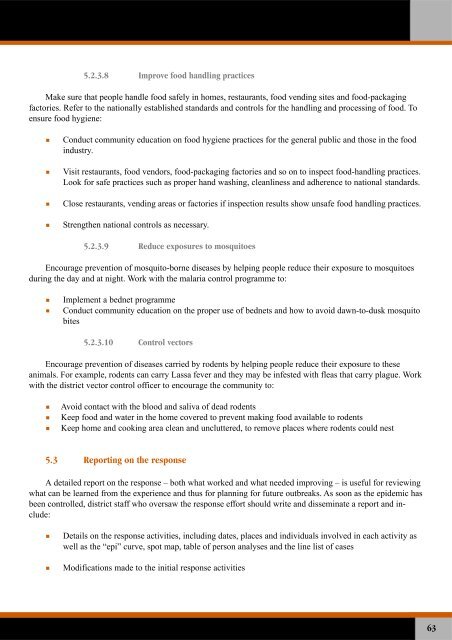Technical Guidelines for Integrated Disease Surveillance ... - PHRplus
Technical Guidelines for Integrated Disease Surveillance ... - PHRplus
Technical Guidelines for Integrated Disease Surveillance ... - PHRplus
Create successful ePaper yourself
Turn your PDF publications into a flip-book with our unique Google optimized e-Paper software.
5.2.3.8 Improve food handling practicesMake sure that people handle food safely in homes, restaurants, food vending sites and food-packagingfactories. Refer to the nationally established standards and controls <strong>for</strong> the handling and processing of food. Toensure food hygiene:Conduct community education on food hygiene practices <strong>for</strong> the general public and those in the foodindustry.Visit restaurants, food vendors, food-packaging factories and so on to inspect food-handling practices.Look <strong>for</strong> safe practices such as proper hand washing, cleanliness and adherence to national standards.Close restaurants, vending areas or factories if inspection results show unsafe food handling practices.Strengthen national controls as necessary.5.2.3.9 Reduce exposures to mosquitoesEncourage prevention of mosquito-borne diseases by helping people reduce their exposure to mosquitoesduring the day and at night. Work with the malaria control programme to:Implement a bednet programmeConduct community education on the proper use of bednets and how to avoid dawn-to-dusk mosquitobites5.2.3.10 Control vectorsEncourage prevention of diseases carried by rodents by helping people reduce their exposure to theseanimals. For example, rodents can carry Lassa fever and they may be infested with fleas that carry plague. Workwith the district vector control officer to encourage the community to:Avoid contact with the blood and saliva of dead rodentsKeep food and water in the home covered to prevent making food available to rodentsKeep home and cooking area clean and uncluttered, to remove places where rodents could nest5.3 Reporting on the responseA detailed report on the response – both what worked and what needed improving – is useful <strong>for</strong> reviewingwhat can be learned from the experience and thus <strong>for</strong> planning <strong>for</strong> future outbreaks. As soon as the epidemic hasbeen controlled, district staff who oversaw the response ef<strong>for</strong>t should write and disseminate a report and include:Details on the response activities, including dates, places and individuals involved in each activity aswell as the “epi” curve, spot map, table of person analyses and the line list of casesModifications made to the initial response activities63















